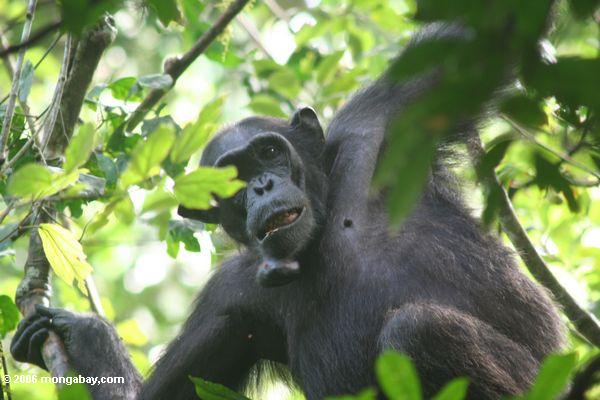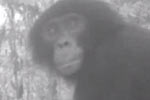Climate change could make life more difficult for the world’s rarest chimpanzee subspecies, reported a team of scientists in the journal BMC Evolutionary Biology on Tuesday.
The range of the Nigeria-Cameroon chimpanzee (Pan troglodytes ellioti) spans the border of its namesake countries, and it inhabits mountain rainforests as well as the transition zone between the forest and the savanna – what scientists call an “ecotone.” About half of the 6,000 remaining Nigeria-Cameroon chimpanzees live in the rainforests in northwest Cameroon and eastern Nigeria, and the other half inhabit the ecotone in central Cameroon.
A team of scientists led by ecologist Paul Sesink Clee used models produced by the United Nations’ Intergovernmental Panel on Climate Change to predict how these habitats might change through the year 2080. They found that for part of the population, changes to the chimpanzees’ environment resulting from climate change could happen as soon as early as 2020.
A female chimpanzee (Pan troglodytes) with a growth on its face. Photo taken in Uganda by Rhett A. Butler.
The researchers’ models show the rainforest habitat looks like it will stand up pretty well to climate change through this century. The chimpanzees living in the ecotone, however, with elements of woodland, forest, and savanna, are likely to see a decline in the ability of their environs to support them.
“You look at any of the three scenarios for 2020 – that’s five years from now – and the habitat has lost a lot,” said Sesink Clee, who is a doctoral student at Drexel University in Philadelphia. “I wasn’t expecting to see such a drastic difference between the two subpopulations,” he added.
What the modeling doesn’t tell scientists is how the affected chimpanzees will respond to changes in their environment. “When climate change happens and habitat is lost, the options are to adapt to your new climate, to migrate to suitable habitats or to go extinct,” Sesink Clee told mongabay.com.
While the ecotone chimps may find a way to adapt, migration does not appear to be an option. “It doesn’t look like there’s too much suitable habitat” for them to migrate to, Sesink Clee said. The team determined suitability for each subgroup by examining factors such as temperature, rainfall, elevation and the density of the forest.
Sesink Clee’s paper is one of three published Tuesday in BMC Evolutionary Biology on chimpanzees. He built much of his work on the storehouse of chimpanzee genetic data amassed by his collaborators over the past two decades. By mapping the habitats of genetically unique groups of animals, they are beginning to tease apart the interplay between habitat and a population’s collective genetics.
One of the aims of Sesink Clee’s study was to prove statistically “that the distinct populations of chimps in Cameroon are all exploiting distinct habitats,” he said. In doing so, “we can start to lead toward the idea that habitat type is going to be really important in shaping the population genetics of these subspecies in this area,” he added.
It’s evidence for what the paper refers to as “isolation by environment.” Similar to the way the Sanaga River that runs across southern Cameroon divides the Nigeria-Cameroon chimpanzee from the Central subspecies, different habitats encourage genetic variation and divergence. The two groups’ evolutionary split occurred 200,000 to 250,000 years ago.
Another of the studies found that this link between habitat and genetics was considerably stronger for the Nigeria-Cameroon chimpanzee than for other subspecies. “From that, we would expect that changes in habitat due to climate or deforestation or agricultural plantations could be much more detrimental to this subspecies compared to the central chimpanzee in the south,” he said.
Data from Global Forest Watch shows a plethora of threats throughout the range of the Nigeria-Cameroon chimpanzee. Logging and oil palm concessions dot the habitat, and there are several dense centers of human population throughout the area.

Maps showing the range of the Nigeria-Cameroon chimpanzee (P. t. ellioti) and the threats to its habitat, including large-scale agriculture, logging and human population density. Maps courtesy of Global Forest Watch and Sesink Clee et al., 2015. Click to enlarge.
Sesink Clee’s research “tells us something about how we need to be conserving populations going into the future,” said ecologist Tom Smith of the University of California, Los Angeles. Smith was not affiliated with this study, though he and Sesink Clee are part of a new initiative funded by the National Science Foundation called the Central African Biodiversity Alliance to examine the effects on climate change on a number of other plant and animal species in Central Africa.
Nearly 20 years ago, Smith and his colleagues developed a hypothesis published in the journal Science that argued for the critical role in promoting biodiversity and genetic variation of these transition zones between different types of habitat. Since that time, evidence from “a growing list of species” has demonstrated the importance of these “environmental gradients,” but Sesink Clee’s research is the first to do so in primates, said Smith.
“This study adds to the growing number of studies showing that we need to pay attention to these environmental gradients because that’s where the action is with respect to natural selection and divergence and speciation,” Smith said.
This line of thinking was further confirmed by a 2010 study by Smith and his collaborators in the journal PLoS ONE that demonstrated what happens when humans alter these unique habitats. They looked at the variation within a bird species, the little greenbul (Andropadus virens) in ecotones that had been deforested in West Africa and in more intact habitats in Central Africa. They found that little greenbul populations in Central Africa had a greater variety of physical traits compared to those in West Africa.
The authors concluded that changes to the little greenbul’s habitat in West Africa resulted in that loss. Such research points to the need to “capture” these gradients within protected areas to preserve this variation and increase the chances that species are equipped with the genetic diversity necessary to allow them to adapt to future changes to their habitats, including the effects of climate change.
“By protecting them, it can give you a kind of bet hedging approach to preserving biodiversity under climate change,” Smith added.
Citations:
“Logging.” World Resources Institute. Accessed through Global Forest Watch on 21 January 2015. www.globalforestwatch.org.
“Oil Palm.” World Resources Institute. Accessed through Global Forest Watch on 21 January 2015. www.globalforestwatch.org.
Global Rural-Urban Mapping Project, Version 1 (GRUMPv1) D.L. Balk, U. Deichmann, G. Yetman, F. Pozzi, S.I. Hay and A. Nelson. Determining Global Population Distribution: Methods, Applications and Data., Advances in Parasitology 62: 119-156, 2006. www.globalforestwatch.org.
Freedman, Adam H., Wolfgang Buermann, Edward T a Mitchard, Ruth S. de Fries, and Thomas B. Smith. 2010. “Human Impacts Flatten Rainforest-Savanna Gradient and Reduce Adaptive Diversity in a Rainforest Bird.” PLoS ONE 5 (9): 1–9. doi:10.1371/journal.pone.0013088.
Paul R Sesink Clee, Ekwoge E Abwe, Ruffin D Ambahe, Nicola M Anthony, Roger Fotso, Sabrina Locatelli, Fiona Maisels, Matthew W Mitchell, Bethan J Morgan, Amy A Pokempner and Mary Katherine Gonder. BMC Evolutionary Biology 2015. doi: 10.1186/s12862-014-0275-z.
Smith, Thomas B, Robert K Wayne, Derek J Girman, and Michael W Bruford. 1997. “A Role for Ecotones in Generating Rainforest Biodiversity.” Science 1855. doi:10.1126/science.276.5320.1855.
}}
Related articles
|
Scandal and intrigue overshadow environment at the Simandou mine in Guinea (01/20/2015) Critically Endangered chimpanzees stand to lose their home over giant iron mine in West Africa. When I was a Peace Corps Volunteer in West Africa decades ago well-laid plans often crumbled to dust in the unpredictable confusion of life there. We just muttered with resignation, ‘WAWA’ – West Africa wins again. The Simandou iron ore mine in Guinea could be one of the biggest WAWAs the region has ever produced. |
|
One clever ape: new book celebrates real-life Orangutan Houdini (01/07/2015) An interview with Laurel Neme about her new children’s book, Orangutan Houdini. When no one is looking, a gangly orangutan named Fu Manchu reaches into his mouth and pulls out a wire. Carefully, Fu, housed at the Henry Doorly Zoo in Nebraska, begins to pick the lock to his enclosure’s door, and escapes! He and his orangutan cohort have the run of the zoo, until his keeper Jerry brings them all back home. |
|
Camera traps capture rare footage of wild bonobos (video) (12/29/2014) Bonobos, our ape cousins, love peace. Unlike chimpanzees, also our close relatives, bonobos are known to resolve conflict through sex instead of aggression. They kiss, they caress, and females display genito-genital rubbing (also called G-G rubbing) to communicate, bond, and reconcile. |
|
Saving the world’s rarest primate: can it be done? (12/17/2014) Endemic to China’s southernmost province of Hainan, only around 30 Hainan gibbons survive today. Rapid island-wide deforestation and consequential loss of habitat, uncontrolled hunting, and failed captive breeding attempts have pushed this ape towards the precipice of becoming the first primate species to go extinct in the modern world. Will a multi-stakeholder conservation strategy be able to save it? |
|
Gibbon species pushed towards extinction as island loses its trees (12/15/2014) Only about 30 Hainan gibbons currently inhabit our world and all of them are confined to the 2,100-hectare Bawangling National Nature Reserve on the western part of Hainan Island. Endemic to this island, these gibbons primarily inhabited the lowland broadleaf and semi-deciduous monsoon forests that today are almost entirely deforested. |
|
Bamboo could help fight global warming (12/11/2014) Restoring degraded land and forests with the world’s fastest growing plant, bamboo, can contribute to major carbon emission reductions. This is according to a new report that discusses the massive potential of bamboo in fighting global warming, with bamboo forests projected to store more than one million tons of carbon by 2050 in China alone. |
|
Tribal violence comes naturally to chimpanzees (12/08/2014) It all went to hell when Jane Goodall started handing out bananas. Within a few years, the previously peaceful chimpanzees she was studying split into two warring tribes. Gangs of males from the larger faction systematically slaughtered their former tribemates. All over the bananas. Or so the argument goes. |







